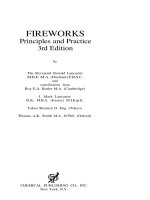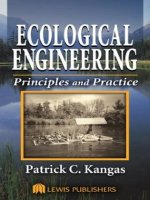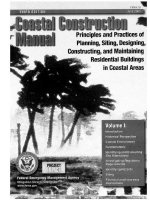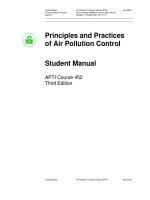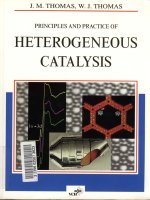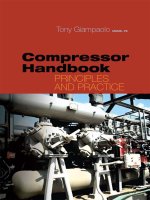Offshore Geotechnical Engineering Principles and practice
Bạn đang xem bản rút gọn của tài liệu. Xem và tải ngay bản đầy đủ của tài liệu tại đây (33.63 MB, 554 trang )
thom
Q
Offshore
geotechnical
• •
engineering
Principles and practice
E.
T.
R.
Dean
Offshore geotechnical engineering
Principles and practice Offshore geotechnical
• •
engineering
Principles and practice
E.T.R. Dean
Soil
Models
Limited
Published
by
Thomas Telford Limited, 40 Marsh Wall, London E14 9TP,
UK.
www.thomastelford.com
Distributors
for
Thomas Telford books are
USA:
ASCE Press, 1801 Alexander
Bell
Drive, Reston, VA 20191-4400
Australia: DA Books and Journals, 648 Whitehorse Road, Mitcham 3132, Victoria
First published
2010
Also available from
Thomas
Telford Limited
Disturbed
soil
properties
and
geotechnical
design.
A. Schofield. ISBN: 978-0-7277-2982-8
A
short
course
in
geotechnical
site
investigation.
N.
Simons,
B.
Menzies,
M.
Matthews.
ISBN: 978-0-7277-2948-4
ICE manual
of
geotechnical
engineering.
J.
Burland, T. Chapman, H. Skinner and
M.
Brown.
ISBN: 978-0-7277-3652-9
www.icevirtuallibrary.com
A catalogue record
for
this book
is
available
from
the British Library
ISBN: 978-0-7277-3641-3
© Thomas Telford Limited 2010
Whilst every reasonable effort has been undertaken
by
the author and the publisher to
acknowledge copyright on material reproduced, if there has been an oversight please contact
the publisher who
will
endeavour to correct this upon a reprint.
All rights, including translation, reserved. Except
as
permitted
by
the Copyright, Designs and
Patents Act 1988, no part of this publication may
be
reproduced, stored in a retrieval system or
transmitted
in
any form or
by
any means, electronic, mechanical, photocopying or otherwise,
without the prior written permission of the
Publisher, Thomas Telford Limited, 40 Marsh Wall,
London E14
9TP.
This book
is
published on the understanding that the author are
so
le
ly
responsible
for
the
statements made and opinions expressed in it and
that
its publication does not necessarily imply
that
such statements and/or opinions are or reflect the views or opinions of the publishers.
While every effort has been made to ensure that the statements made and the opinions
expressed in this publication provide a
safe
and accurate guide, no
li
abiliry or responsibiliry can
be accepted in
this respect
by
the author or pub
li
shers.
F,;S
FSC
Mixed
Sources
Product
gr
oup
from
weU·managed
forests
and
other
[ontrolled
sou
r
ces
Cert
no.
SGS·COC·Z953
www.he.org
o 1996 Forest
Stew;ll
rdshlp
CCI\Incil
Typeset
by
Academic + Technical, Bristol
Index created
by
Indexing Specialists
(UK)
Ltd, Hove, East Sussex
Printed and bound in Great Britain
by
Antony
Rowe
Limited, Chippenham
Dedication
Offshore geotechnical engineering owes
much
to the historical develop-
ments of soil mechanics
by
Karl Terzaghi, Donald Taylor,
Arthur
Casagrande, Ral
ph
Peck, Harry Seed, Alec Skempton, Laurits
Bjerrum, Andrew Schofield and others. A major part
of
our current
knowledge of offshore geotechnical engineering has been developed
by
countless geotechnical engineers, managers, and others in the
offshore industry itself. This book
is
dedicated
to
all those who have
contributed to the subject, and who continue to contribute and share
their knowledge.
v
Dedication
Preface
Acknowledgements
Notation
Standards
of
codes
of
practice
Some useful web sites
v
xi
xiii
xv
xxvii
xxxi
1
Introduction
1
1.1
Nature
of
offshore geotechnical engineering 1
1.2 Development processes
for
offshore energy resources 14
1.3
Geohazards 18
1.4 Geotechnical design 24
2 Offshore surveys
and
site investigations 29
2.1
Introduction 29
2.2
Shallow geophysical surveys 32
2.3
Shallow-penetration geotechnical surveys 40
2.4 Deep-penetration geotechnical site investigations 46
2.5 Visual-manual sample inspection, logging, and packing 61
2.6 Offshore laboratory testing 68
2.7 Interpreting
CPT
data
81
2.8 Developing a geotechnical site model 84
3
Soil
mechanics
93
3.1 Formation
of
offshore soils 93
3.2 Classification and basic properties
of
offshore soils 96
3.3
Stress and strain in soils 103
3.4 Fluid
flow
through soils 108
3.5 Compressibility and yielding
of
soils 113
vii
3.6
Practical approaches
for
soil strength
124
3.7
Practical approaches
for
cyclic loading
131
3.8
Theory
of
applied elasticity
139
3.9
Theory
of
bearing capacity
146
3.10
Other
stability analyses
151
3.11
Consolidation and
other
time-related processes
158
3.12
Sample integrity
165
4
Jackup
platforms
169
4.1
Introduction
169
4.2
Independent-legged jackups
173
4.3
Foundation assessment for installation
178
4.4
Failure modes
194
4.5
Dynamic analysis
197
4.6
Bearing capacity and sliding checks
202
4.7
Mat-supported jackups
216
4.8
Site departure
219
5
Jacket
platforms
221
5.1
Introduction
221
5.2
Temporary on-bottom support during installation
229
5.3
Pile installation
234
5.4
Ultimate axial pile capacity
251
5.5
Axial pile performance
265
5.6
Lateral pile performance
273
5.7
Ultimate lateral pile capacity
283
5.8
Cyclic loading of piles
290
5.9
Pile groups
292
5.10
De-commissioning
295
6 C7ravity platforms
I
296
6.1
Types of gravity platform
296
6.2
Construction
and
installation
299
6.3
Design codes and issues
301
6.4
Environmental conditions
302
6.5
Site investigations for gravity platforms
303
6.6
Geotechnical design for installation
305
6.7
Hydrodynamic loads
307
6.8
Geotechnical design for cyclic and dynamic loading
309
6.9
Geotechnical design for dynamic and seismic loading
322
6.10
Geotechnical design of skirts
325
viii
6.11
Geotechnical design for consolidation and settlement
329
6.12
Monitoring and validation
336
6.13
Decommissioning
337
7 Pipelines, flowlines, cables,
and
risers
7.1
Introduction
8
9
7.2
Pipeline and cable route selection
7.3
Installation
7 A Positional instabilities of pipelines
7
.5
Riser-seabed interactions
7.6
Shore approaches
Artificial islands
8.1
Introduction
8.2
Geotechnics of artificial islands
8.3
Slope protection
8A
Calculations for ultimate limit states
8.5
Calculations for serviceability limit states
8.6
Instrumentation and monitoring
8.7
Decommissioning
Deep
and
ultra,
deep
water
9.1
Introduction
9.2
Site investigations
9.3
Deepwater soils
9A
Suction-installed foundations
9.5
Tension foundations
9.6
Anchors
9.7
Decommissioning
10
Renewable energy
10.1
Introduction
10.2
Offshore wind farms
10.3
Geotechnical design
lOA
Site investigation
10.5
Other
offshore renewable energy options
References
Index
338
338
342
347
356
370
371
373
373
379
385
388
394
396
396
397
397
401
402
405
414
418
425
427
427
428
438
444
448
449
507
ix
Interest in the construction and development of offshore structures
is
increasing for several reasons. Demand for hydrocarbons makes offshore
oil and
gas
commercially attractive. Increasing interest
in
renewable
energy has made offshore wind farms attractive, and wave, current,
and tidal energy systems will soon be financially viable.
And
artificial
islands provide real estate
not
available onshore. All these structures
are subject to significant geohazards, and require foundations to suit
the structural weight and applied loads. Offshore geotechnical
engin-
eering
is
the practical science
that
addresses this.
This book presents the core design skills for this subject. It
is
self-
contained, and can be used
as
a comprehensive primer for those new
to offshore structures, or
as
a course text for students.
It
is
advisable
that
readers have a prior understanding of soil mechanics
and
founda-
tion engineering. Chapter 3 provides an overview of
the
main points,
as
they apply to offshore engineering, for readers without
the
advisable
prerequisites.
The book
is
designed
as
an introduction to
an
extensive literature,
but
not
as
a replacement for
that
literature. Readers should also explore the
offshore standards and codes of practice, listed
at
the start of this book.
The most widely used practice has been
API RP2A. Readers should
also expect to read widely, particularly proceedings of the Offshore
Technology Conference
(OTC) held in Houston, Texas every May
(www.otcnet.org).
The
following are also particularly recommended:
• Randolph, M.F., Cassidy, M.J., Gourvenec,
S.
and
Erbrich,
c.J.
2005. Challenges of offshore geotechnical engineering. State of
the art paper.
16th
International
Conference
on
Soil
Mechanics
and
Geotechnical
Engineering.
Millpress Science Publishers, Vol.
1,
123-176.
• ISSMGE TC1 2005.
Geotechnical
and
Geophysical
Investigations
for
Offshore
and
Nearshore
Developments.
Technical Committee 1 of
xi
the International Society of Soil Mechanics and Geotechnical
Engineering. Downloadable from www.offshoregeohazards.org.
• Lunne, T., Robertson, P.K. and Powell, J.J.M. 1997.
Cone
Penetration
Testing
in
Geotechnical
Engineering.
Blackie Academic and Professional.
•
Schnaid,
F.
2009. In
Situ
Testing
in
Geotechnics:
The
Main
Tests.
Taylor
and
Francis.
• Davis, R.O. and Selvadurai, A.P.S. 1996.
Elasticity
and
Geornechanics.
Cambridge University Press.
•
Davis, R.O. and Selvadurai, A.p.s. 2002.
Plasticity
and
Geomechanics.
Cambridge University Press.
The
offshore industry
is
very innovative. Research
is
well funded, and
results are quickly and carefully used
in
practice.
The
book
Frontiers
in
Offshore
Geotechnics
(edited
by
S.
Gourvenec and M.J. Cassidy,
and published
by
Taylor
and
Francis, 2005), describes some of the
recent work.
Readers might like to consider becoming a member of the
Society
for
Underwater Technology, the International Society of Offshore and Polar
Engineers, and/or the Society of Petroleum Engineers.
To
work offshore,
you will likely need to obtain, through an employer, a certificate of Basic
Offshore
Safety, Induction, and Emergency Training (BOSIET) including
Helicopter Underwater Escape Training
(HUET). It can also be helpful
to obtain a seaman's card.
Good luck!
xii
E.
T.
Richard
Dean
2009
Acknowledgements
I would like to
thank
many friends and colleagues in
the
offshore
industry who encouraged me to write this book and who made many
constructive criticisms and suggestions for improvements to
an
early
draft, including in alphabetical order:
• Dr Andrew
J.
Brennan, University
of
Dundee, UK
•
Dr David Cathie, Christophe Jaeck, and others
at
Cathie Associates,
Belgium
• Dr Dick Lyons and staff of Geotechnical Engineering
and
Marine
Surveys (GEMS
UK) Limited
• Dr Gopal Madabhushi, of Cambridge University, UK
•
Dr Indrasenan Thusyanthan, of
KW
Limited, UK
•
Dr Jack Templeton III, of Sage Engineering Inc, Houston,
USA
• Dr Milutin Srbulov of
Mott
Macdonald Limited, UK
•
Patrick Wong, ExxonMobil Development Company, Houston,
USA
• Stefan Deokiesingh, Satesh Ramsaroop, and Kavita Fulchan
and
others of Capital Signal Company Limited, Trinidad.
I would also like to
thank
all
my
students
at
the
University of the
West Indies
(UWI) , who
put
up with
the
first drafts of the lecture
notes, and Jennifer Pappin-Ramcharan,
Unika Omowale, and others
who
assisted me greatly at UWl's Main Library in St. Augustine,
Trinidad. I would like to
thank
the
staff
of
Thomas Telford for their
patient help and guidance, including Daniel Keirs, Jennifer Barratt,
Terri Harding and others,
as
well
as
Debra Harding and
other
staff of
the Institution of Civil Engineers' Library
in
London.
I would also like to
thank
friends and family for their patience while
the book
was
being written, and
my
dear friend Jessie Moses for
her
sharp wit and warm encouragement during this time.
Pennission to reproduced figures excerpted from copyrighted material
is
gratefully acknowledged,
as
indicated
on
relevant figures. Every effort
has
been made to ensure
that
appropriate acknowledgement has been
xiii
made to previous copyrighted works quoted herein, and to contact
all
such copyright holders. If an omission in this matter have been made,
the publishers and author apologise in advance, and shall rectify
all
errors brought to their attention in the next edition.
Any opinions
that
may be expressed in this book are mine alone,
and do
not
necessarily represent the opinions of
other
persons or any
organisations. All mistakes are mine: if you find one please contact
the publisher.
xiv
Notation
Conventions
In this book, stress and strain are taken positive in compression.
Work
is
taken
as
positive when it
is
done
on
a body, such
as
a body of soil.
Angles are taken positive anticlockwise.
Full differentials are denoted using the pre-symbol
d.
For example,
dx
is
the full differential for
x.
Differentials are always a result of starting
by
considering a small quantity, denoted using the symbol
8,
then
consid-
ering the case of smaller and smaller values
of
that
quantity. For
example, if a small change
8cr
in stress occurs when a body
is
subjected
to a small change
8h
in height,
then
the quantity
8cr/8h
may tend to a
limit
as
8h
tends to zero.
The
limit
is
denoted
as
dcr/dh
if a full differen-
tial
is
relevant, or
acr
/
ah
if a partial differential
is
relevant.
Units
Most quantities in this book are in SI units, which are described
in
the
paper entitled
'SI units for geotechnical engineering' (Committee
on
Definitions and Standards of the Geotechnical Division, 1983, ASCE
Journal
of
Geotechnical
Engineering,
109(12),
1534-1538).
Exception-
ally,
Imperial units are used, e.g. some pile
sizes
given
in
inches,
as
this
is
common in the industry.
The
following conversion factors may
be useful:
1 inch = 25.4 mm
1 foot = 0.3048 m
1 pound (mass) = 0.453592
kg
1 kip (force) = 4.448222 kN
1 kg/m
2
(force) = 9.80665 N/m2
1 psi (pounds-per-square-inch, stress) = 6.894757 kPa
1 ksi (kips-per-square-inch, stress) = 6.894757 MPa
1 MN =
1000kN
xv
1 kN =
1000N
1
Pa=
1 N/mz
Some units involve
an
unmentioned application of the acceleration g of
gravity, such
as
kg/mz.
It
is
best to avoid these units wherever possible,
as
great confusion
can
result. Mixed units
can
make sense,
but
are
preferably avoided. For example, 1
kPa!ft
is
the same
as
1 kN/mz
for
each 0.3048
m,
which equates to 1/0.3048
>=::j
3.2808 kN/mz
for
every
metre,
so
is
about
the
same
as
3.2808 kN/m
3
.
Angles are assumed to be given in radians unless the symbol °
for
degrees
is
used. Conversion to consistent units
is
implicitly assumed
in all arithmetic calculations. For example,
(1
+
())
e
Zo
evaluates to
(1
+
7r)
e
Z1r
if
()
= 180°.
Another
example: tan(45° + ¢/2) evaluates to
J3 if ¢ =
7r/6
radians.
Fractions may be expressed
as
percentages or vice versa. Conversion
to consistent units
is
implicitly assumed
in
all calculations. For example,
(1
+ w) evaluates to 2.5 if w = 150%.
Notes
Where
the same symbol
is
listed below with more
than
one meaning,
the
meaning will be clear from the context where the symbol
is
used.
Units are specified in square brackets, For instance, [ML
-IT-Z]
is
a
stress
(=
mass x acceleration/area).
Symbols
a
a
a
a
A
A
A
A
Ac
Ao
Ap
A'
A'
b
xvi
adhesion [ML
-IT-Z]
constant [dimensionless]
radius
[L]
lever arm
[L]
constant [dimensionless]
area
[Lz]
amplitude multiplication factor [dimensionless]
multiplier in
p - y calculation [dimensionless]
Z
contact area
[L
]
initial area
[Lz]
equivalent cross-sectional area of a pile
[Lz]
effective area
[Lz]
area of reduced foundation
[Lz]
fraction [dimensionless]
b constant [dimensionless]
B constant [dimensionless]
B footing breadth or diameter
[L]
B'
equivalent footing breadth
[L]
BHD borehole
depth
[L]
Bb)
function defining a backbone curve [ML
-IT-
2
]
C cohesion [ML
-IT-
2
]
c wave velocity
[L
T-
I
]
Ch
coefficient of vertical consolidation, with horizontal
drainage
[L
2T-
I
]
C
V
coefficient of vertical consolidation, with vertical
drainage
[L
2
T-
I
]
C constant [dimensionless]
C viscosity
[MT-
I
]
C effective circumference
[L]
C
c
coefficient of curvature [dimensionless]
C
c
compression index [dimensionless]
C
n
constant
(n
= 0,
1,
2,
3
) [dimensionless]
C(p)
factor
in
settlement calculation [dimensionless]
C
s
swelling index [dimensionless]
C
s
factor in settlement calculation [dimensionless]
C
u
coefficient
of
uniformity [dimensionless]
C
n
coefficient of secondary compression [dimensionless]
d water
depth
[L]
do
adjusted depth
[L]
D water depth
[L]
D diameter
[L]
D constrained modulus [ML
-IT-
2
]
D damage [dimensionless]
DN
damage ratio after N cycles [dimensionless]
Dn
largest nominal diameter
of
smallest n % of particles
by
dry weight
[L]
e void ratio [dimensionless]
e eccentricity
[L]
eEOP void ratio at the
end
of primary consolidation
[dimensionless]
e
max
largest void ratio attainable
by
a standard procedure
[ dimensionless]
emin
smallest void ratio attainable
by
a standard procedure
[dimensionless]
E
Young's modulus [ML
-IT-
2
]
xvii
FS
g
g
G
G
max
G
s
G(w)
h
h
xviii
pile group capacity factor [dimensionless]
equivalent Young's modulus for a pile material
[ML-
I
T-
2
]
lateral soil reaction modulus
[ML
-IT-
2
]
secant Young's modulus
[ML
-IT-
2
]
apparent Young's modulus for undrained conditions
[ML-
I
T-
2
]
unit skin friction resistance stress [ML
-IT-
2
]
upper limit
on
the unit skin friction resistance stress
[ML-
I
T-
2
]
reduction factor [dimensionless]
unit skin friction resistance stress for the pull-out of a
pile
[ML
-IT-
2
]
environmental force
[MLT-
2
]
driving force
[MLT-
2
]
product of bearing capacity modifying factors for
cohesion [dimensionless]
pile capacity factor [dimensionless]
product of bearing capacity modifying factors for
surcharge [dimensionless]
compressibility factor [dimensionless]
depth
factor [dimensionless]
inclination factor [dimensionless]
shape factor [dimensionless]
product of bearing capacity modifying factors for
self-
weight [dimensionless]
factor
of
safety [dimensionless]
acceleration due to earth's gravity, usually taken
as
9.81
m/s2
dimensionless parameter
in
shear modulus
determination [dimensionless]
shear modulus
[ML
-IT-
2
]
shear modulus at infinitesimally small strain [ML
-IT-
2
]
average specific gravity of particles [dimensionless]
power spectral density
[L2T2]
offset height
[L]
peak-to-trough amplitude of sinusoidal undulation in
as-laid pipe
[L]
thickness
of
ith
soil layer
[L]
excess head
[L]
initial thickness of a soil layer
[L]
I
IT
Ir,crit
1
ls
k
k
K
K
Ka
Kh
Kp
Ks
KT
K
o
Ko,nc
LI
height
[L]
horizontal force
[MLT-
2
]
horizontal force resultant evaluated at point P
[MLT-
2
]
horizontal force resultant evaluated
at
point Q
[MLT-
2
]
reference horizontal load [ML
T-
2
]
net
horizontal load [ML
T-
2
]
hydraulic gradient [dimensionless]
critical hydraulic gradient [dimensionless]
moment of inertia
[L
4]
rigidity index [dimensionless]
critical rigidity index [dimensionless]
factor for a surface failure mechanism [dimensionless]
Smith damping
[L
-IT]
hydraulic conductivity
[L
T-
I
]
constant [dimensionless]
coefficient of lateral earth pressure [dimensionless]
bulk modulus [ML
-I
T
-2]
active earth pressure coefficient [dimensionless]
effective horizontal stiffness
at
the hull level
[MT-
2
]
passive
earth
pressure coefficient [dimensionless]
punching shear coefficient [dimensionless]
torsional stiffness [ML
2
T-
2
]
coefficient of lateral earth pressure at rest
[dimensionless]
coefficient of lateral earth pressure at rest for a normally
consolidated sample [dimensionless]
vertical stiffness
[MT-
2
]
horizontal stiffness
[MT-
2
]
rotational stiffness [ML
2
T-
2
]
stiffness ratio [dimensionless]
lifetime
in
years [T]
lever arm
[L]
water wavelength
[L]
length of
flow
path
[L]
leg length
[L]
length of the longest side of a rectangular strip footing
[L]
height from the spudcan bearing area to the centre
of
mass of a jackup
liquidity index [dimensionless, fraction or
%]
xix
LL
m
m
mv
M
M
M
Mh
MiP
MiQ
M
iO
n
n
n
N
N
N
Nc
Nc
Ni
Ni,f
Nk
Nkt
N
q
N
q
N'Y
OCR
P
P
P
pi
PI
Pu
Po
p
p
xx
liquid limit [dimensionless, fraction or
%]
constant [dimensionless]
counter [dimensionless]
coefficient of volume change
[M-
I
L
T2]
mass
[M]
overturning moment [ML
2
T-
2
]
series parameter [dimensionless]
mass of a hull
[M]
moment resultant evaluated
at
point P [ML
2
T-
2
]
moment resultant evaluated
at
point Q [ML
2
T-
2
]
reference moment [ML
2
T-
2
]
porosity [dimensionless, fraction or
%]
constant [dimensionless]
load spreading factor [dimensionless]
number
of
years [T]
stability number [dimensionless]
normal resistance per unit length
[MT-
2
]
cone factor [dimensionless]
bearing capacity factor for cohesion [dimensionless]
number of cycles of type
i
number of cycles of type i required to reach a specified
condition
cone factor [dimensionless]
cone factor [dimensionless]
bearing capacity factor for surcharge [dimensionless]
pile
end
bearing capacity factor [dimensionless]
bearing capacity factor for self-weight [dimensionless]
overconsolidation ratio
mean normal total stress
[ML-
I
T-
2
]
pressure inside pipe [ML
-IT-
2
]
lateral soil resistance force per unit length
[MT-
2
]
mean normal effective stress [ML
-IT-
2
]
probability of occurrence in a period of 1 year
[dimensionless]
reference (standard atmospheric) pressure
= 100 kN/m2
probability of occurrence in a period of
N years
[dimensionless]
ultimate lateral shaft resistance per unit length
[MT-
2
]
pressure amplitude [ML
-IT-
2
]
length of pipe
[L]
axial force [MLT-
2
]
P
t
PI
PL
q
q
q
qp
qu
quit
qu,net
qu,net,b
Qsx
Qt
Qu
Qws
Y
Y
Yf
Y
m
R
R
point load
[MLT~2]
force due to pressure
in
contained fluids
[ML
T~2]
force contribution associated with
the
weight
of
the
soil
cover
[MLT~2]
negative
offorce
in a pipe
[MLT~2]
plasticity index [dimensionless, fraction or
%]
plastic limit [dimensionless, fraction or
%]
deviator stress
[ML
~lT~2]
surcharge
[ML
~lT~2]
vertical effective stress
at
the
level
of
the
bearing area
[ML
~lT~2]
unit
end
bearing resistance stress
[ML
~lT~2]
available bearing capacity
[ML
~lT~2]
cone resistance
[ML
~lT~2]
upper limit
on
the
unit
end
bearing resistance stress
[ML~lT~2]
unit
point resistance
[ML
~lT~2]
ultimate
unit
bearing capacity
[ML
~IT~2]
ultimate
unit
bearing capacity
[ML
~lT~2]
net
ultimate
unit
bearing capacity
[ML
~lT~2]
net
ultimate
unit
bearing capacity
of
an
underlying layer
[ML
~lT~2]
volume flow rate
[L3T~2]
shear force
[MLT~2]
vertical load capacity
of
a
mudmat
[MLT~2]
ultimate point resistance force
on
a steel annulus
[ML
T~2]
ultimate point resistance force
beneath
a soil plug
[MLT~2]
ultimate point resistance force
[ML
T~
2]
ultimate internal shaft friction resistance force for a
coring pile
[MLT~2]
ultimate external shaft friction resistance force
[MLT~2]
ultimate capacity in tension
[ML
T~2]
ultimate load
[MLT~2]
frictional resistance
under
the
working load
[MLT~2]
radius
[L]
radius
of
gyration
[L]
failure ratio [dimensionless]
radius
of
zone
of
influence
[L]
radial distance
[L]
skirt resistance
[MLT~2]
xxi
S
Su,remoulded
T
T
T
T
Tend
Tr
Tside
Tv
U
U
g
U
xs
xxii
lateral resistance
[MLT-
2
]
shear resistance per unit length
[MT-
2
]
load ratio [dimensionless]
skirt or dowel resistance due to
end
bearing
[MLT-
2
]
skirt or dowel resistance due to wall friction
[MLT-
2
]
shaft resistance per unit length
[MT-
2
]
relative density [dimensionless, fraction or
%]
settlement
[L]
undrained shear strength
[ML
-I
T
-2]
undrained shear strength for a normally consolidated
sample
[ML
-IT-
2
]
undrained shear strength for a remoulded sample
[ML
-IT-
2
]
degree of saturation [dimensionless, fraction or
%]
leg spacing
in
elevation view
[L]
shear resistance per unit length
[MT-
2
]
sensitivity to remoulding [dimensionless, fraction]
sensitivity [dimensionless, fraction]
height of stick-up
[L]
time [T]
wall thickness
[L]
shaft resistance force per unit length
[MT-
2
]
maximum shaft resistance per unit length
[MT-
2
]
duration from the application
of
a load to the end of
primary consolidation [T]
mass of tare
[M]
wave period [T]
change
in
the temperature
[OK]
anchor line tension
[MLT-
2
]
end torque
[ML
2T-
2
]
time factor [dimensionless]
side torque
[ML
2
T-
2
]
time factor [dimensionless]
pore water pressure
[ML
-IT-
2
]
excess pore pressure generated
at
a point [ML
-1
T-
2]
excess water pressure [ML
-IT-
2
]
water pressure
on
the seafloor
[ML
-IT-
2
]
initial velocity [L
T-
I
]
average degree of consolidation [dimensionless]
average degree of consolidation for radial drainage
[dimensionless]
U
v
average degree of consolidation for vertical drainage
[dimensionless]
v vertical displacement
[L]
v discharge velocity
[L
T-
1
]
Vr discharge velocity in
the
radial direction
[L
T-
1
]
V
Z
discharge velocity in the z direction
[L
T-
1
]
Vsw
velocity of a sound wave through water
[L
T-
1
]
x position coordinate
[L]
x depth below the seafloor
[L]
XR depth of reduced resistance
[L]
V volume
[L
3
]
V specific volume [dimensionless]
V vertical load
[MLT-
2
]
V vertical load capacity per unit length
[MT-
2
]
ViP
vertical force resultant evaluated
at
point P
[MLT-
2
]
V
iQ
vertical force resultant evaluated at point Q
[MLT-
2
]
V
it
tension load capacity (positive for tension)
[MLT-
2
]
Via
reference vertical load [ML
T-
2]
Vult
ultimate vertical load [ML
T-
2]
Va
reference vertical load [ML
T-
2
]
W vertical displacement
[L]
W width
[L]
w wall thickness
[L]
w water
content
[dimensionless, fraction or
%]
w force per unit length
[MT-
2
]
w penetration distance
[L]
Wi
initial force per unit length
[MT-
2
]
W'
buoyant weight
[MLT-
2
]
W
max
maximum buoyant weight of backfill
[MLT-
2
]
W
net
net
vertical load
[MLT-
2
]
WD
water
depth
[L]
Y lateral displacement
[L]
Yc
lateral offset due to construction tolerances
[L]
Yc
reference displacement
[L]
Yw
lever arm
[L]
Yx,i
lateral displacement of point
on
the
ith
leg relative to
the hull
[L]
Z depth below the seafloor
[L]
Z3
component of settlement due to settlement of material
below the level
of
the pile tip
[L]
z'
distance above a layer boundary
[L]
xxiii
Zlim limiting
depth
of a stable vertical
cut
in clay
[L]
Z section modulus
[L
3
]
a multiplier [dimensionless]
a coefficient of thermal expansion [dimensionless, per K]
j3
multiplier [dimensionless]
j3
load inclination angle [dimensionless, radians or degrees]
j3
wavenumber
[L
-1]
t5
small change in (e.g.
t5x
= small change in
x)
t5
soil-pile friction angle [dimensionless, degrees or radians]
C phase lag [dimensionless, degrees or radians]
C
ax
axial strain [dimensionless, fraction or %]
C
c
axial strain
at
50%
of
the
maximum deviator stress in a
UU
test [dimensionless]
Cnet
net
axial strain [dimensionless, fraction or
%]
C
r
radial strain [dimensionless, fraction or
%]
Ct
thermally induced strain [dimensionless, fraction or
%]
Cval volumetric strain [dimensionless, fraction or
%]
C
xx
axial strain in
the
x direction [dimensionless, fraction
or
%]
C
yy
axial strain in the y direction [dimensionless, fraction
or%]
c
zz
axial strain
in
the
Z direction [dimensionless, fraction
or
%]
¢' effective angle of internal friction [dimensionless,
degrees or radians]
¢~s
effective angle of internal friction at a critical state
[dimensionless, degrees or radians]
¢hi
horizontal fixity
at
the ith spudcan [dimensionless]
¢~ab
mobilised angle of effective (internal) friction
[dimensionless, degrees or radians]
¢ri
moment fixity at the
ith
spudcan [dimensionless]
I engineering shear strain [dimensionless, angle or
fraction]
I'
submerged unit weight [ML
-2T-
2
]
Ib
bulk unit weight [ML
-2T-
2
]
Ibulk
bulk unit weight [ML
-2
T
-2]
Id
dry unit weight [ML
-2T-
2
]
Idry
dry unit weight [ML
-2T-
2
]
leng
engineering shear strain [dimensionless, angle or
fraction]
,:
submerged unit weight of the
ith
soil layer [ML
-2T-
2
]
xxiv


